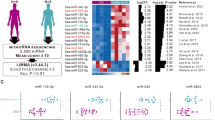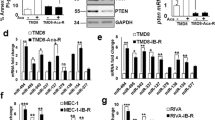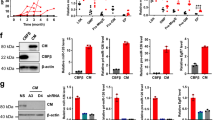Abstract
Abnormal expression of microRNAs (miRNAs) has been implicated in carcinogenesis. Here we report a novel BCR (breakpoint cluster region)-ABL (c-abl oncogene 1, non-receptor tyrosine kinase)/GATA1/microRNA-138 (miR-138) circuitry in chronic myeloid leukemia (CML). miR-138 expression is downregulated in K562 cells and primary CML samples, which is restored after imatinib treatment. The tumor suppressor activity of miR-138 is demonstrated by the induction of cell cycle arrest at G0/G1, inhibition of cell proliferation and colony forming unit granulocyte-macrophage colony formation and enhanced imatinib-induced apoptosis in K562 and Ku812 cells overexpressing miR-138. Moreover, overexpression of miR-138 led to the downregulation of BCR-ABL. Based on luciferase assay, ABL and BCR-ABL are shown to be the target genes regulated by miR-138. Furthermore, miR-138 binding to ABL was shown to localize to the coding region instead of 3′-untranslated regions (3′-UTR) of ABL mRNA. In addition, CCND3 is another target of miR-138, which represses CCND3 expression by binding to its 3′-UTR. Finally, upregulation of miR-138 upon imatinib treatment is associated with the enhancement of GATA1 activity, which binds to the miR-138 promoter. In conclusion, miR-138 is a tumor suppressor miRNA underexpressed in CML. miR-138 represses expression of both BCR-ABL and CCND3 via binding to the coding region and 3′-UTR, respectively. miR-138 expression is activated by GATA1, which in turn is repressed by BCR-ABL. Therefore, miR-138, by virtue of a BCR-ABL/GATA1/miR-138 circuitry, is a tumor suppressor miRNA implicated in the pathogenesis of CML and its clinical response to imatinib.
This is a preview of subscription content, access via your institution
Access options
Subscribe to this journal
Receive 50 print issues and online access
$259.00 per year
only $5.18 per issue
Buy this article
- Purchase on Springer Link
- Instant access to full article PDF
Prices may be subject to local taxes which are calculated during checkout







Similar content being viewed by others
References
Tay Y, Zhang J, Thomson AM, Lim B, Rigoutsos I . MicroRNAs to Nanog, Oct4 and Sox2 coding regions modulate embryonic stem cell differentiation. Nature 2008; 455: 1124–1128.
Spizzo R, Nicoloso MS, Croce CM, Calin GA . SnapShot: MicroRNAs in cancer. Cell 2009; 137: 586–586.
O’Day E, Lal A . MicroRNAs and their target gene networks in breast cancer. Breast Cancer Res 2010; 12: 201.
Nana-Sinkam SP, Geraci MW . MicroRNA in lung cancer. J Thorac Oncol 2006; 1: 929–931.
Li S, Fu H, Wang Y, Tie Y, Xing R, Zhu J et al. MicroRNA-101 regulates expression of the v-fos FBJ murine osteosarcoma viral oncogene homolog (FOS) oncogene in human hepatocellular carcinoma. Hepatology 2009; 49: 1194–1202.
Xu C, Liu S, Fu H, Li S, Tie Y, Zhu J et al. MicroRNA-193b regulates proliferation, migration and invasion in human hepatocellular carcinoma cells. Eur J Cancer 2010; 46: 2828–2836.
Chan JA, Krichevsky AM, Kosik KS . MicroRNA-21 is an antiapoptotic factor in human glioblastoma cells. Cancer Res 2005; 65: 6029–6033.
Bandres E, Cubedo E, Agirre X, Malumbres R, Zárate R, Ramirez N et al. Identification by Real-time PCR of 13 mature microRNAs differentially expressed in colorectal cancer and non-tumoral tissues. Mol Cancer 2006; 5: 29.
Garzon R, Pichiorri F, Palumbo T, Visentini M, Aqeilan R, Cimmino A et al. MicroRNA gene expression during retinoic acid-induced differentiation of human acute promyelocytic leukemia. Oncogene 2007; 26: 4148–4157.
Zanette DL, Rivadavia F, Molfetta GA, Barbuzano FG, Proto-Siqueira R, Silva-Jr WA et al. miRNA expression profiles in chronic lymphocytic and acute lymphocytic leukemia. Braz J Med Biol Res 2007; 40: 1435–1440.
Calin GA, Ferracin M, Cimmino A, Di Leva G, Shimizu M, Wojcik SE et al. A MicroRNA signature associated with prognosis and progression in chronic lymphocytic leukemia. N Engl J Med 2005; 353: 1793–1801.
Morton SU, Scherz PJ, Cordes KR, Ivey KN, Stainier DY, Srivastava D . microRNA-138 modulates cardiac patterning during embryonic development. Proc Natl Acad Sci USA 2008; 105: 17830–17835.
Mitomo S, Maesawa C, Ogasawara S, Iwaya T, Shibazaki M, Yashima-Abo A et al. Downregulation of miR-138 is associated with overexpression of human telomerase reverse transcriptase protein in human anaplastic thyroid carcinoma cell lines. Cancer Sci 2008; 99: 280–286.
Wong TS, Liu XB, Wong BY, Ng RW, Yuen AP, Wei WI . Mature miR-184 as potential oncogenic microRNA of squamous cell carcinoma of tongue. Clin Cancer Res 2008; 14: 2588–2592.
Jiang L, Dai Y, Liu X, Wang C, Wang A, Chen Z et al. Identification and experimental validation of G protein alpha inhibiting activity polypeptide 2 (GNAI2) as a microRNA-138 target in tongue squamous cell carcinoma. Hum Genet 2011; 129: 189–197.
Kisliouk T, Yosefi S, Meiri N . MiR-138 inhibits EZH2 methyltransferase expression and methylation of histone H3 at lysine 27, and affects thermotolerance acquisition. Eur J Neurosci 2011; 33: 224–235.
Liu X, Wang C, Chen Z, Jin Y, Wang Y, Kolokythas A et al. MicroRNA-138 suppresses epithelial-mesenchymal transition in squamous cell carcinoma cell lines. Biochem J 2011; 440: 23–31.
Lewis BP, Burge CB, Bartel DP . Conserved seed pairing, often flanked by adenosines, indicates that thousands of human genes are microRNA targets. Cell 2005; 120: 15–20.
Liu X, Lv XB, Wang XP, Sang Y, Xu S, Hu K et al. MiR-138 suppressed nasopharyngeal carcinoma growth and tumorigenesis by targeting the CCND1 oncogene. Cell Cycle 2012; 11: 2495–2506.
Wang W, Zhao LJ, Tan YX, Ren H, Qi ZT . MiR-138 induces cell cycle arrest by targeting cyclin D3 in hepatocellular carcinoma. Carcinogenesis 2012; 33: 1113–1120.
Deininger MW, Goldman JM, Melo JV . The molecular biology of chronic myeloid leukemia. Blood 2000; 96: 3343–3356.
Krek A, Grun D, Poy MN, Wolf R, Rosenberg L, Epstein EJ et al. Combinatorial microRNA target predictions. Nat Genet 2005; 37: 495–500.
Enright AJ, John B, Gaul U, Tuschl T, Sander C, Marks DS . MicroRNA targets in Drosophila. Genome Biol 2003; 5: R1.
Kruger J, Rehmsmeier M . RNAhybrid: microRNA target prediction easy, fast and flexible. Nucleic Acids Res 2006; 34: W451–W454.
Obernosterer G, Leuschner PJ, Alenius M, Martinez J . Post-transcriptional regulation of microRNA expression. RNA 2006; 12: 1161–1167.
Heinemeyer T, Wingender E, Reuter I, Hermjakob H, Kel AE, Kel OV et al. Databases on transcriptional regulation: TRANSFAC, TRRD and COMPEL. Nucleic Acids Res 1998; 26: 362–367.
Corcoran DL, Pandit KV, Gordon B, Bhattacharjee A, Kaminski N, Benos PV . Features of mammalian microRNA promoters emerge from polymerase II chromatin immunoprecipitation data. PLoS One 2009; 4: e5279.
Pope NJ, Bresnick EH . Differential coregulator requirements for function of the hematopoietic transcription factor GATA-1 at endogenous loci. Nucleic Acids Res 2010; 38: 2190–2200.
Huang DY, Kuo YY, Chang ZF . GATA-1 mediates auto-regulation of Gfi-1B transcription in K562 cells. Nucleic Acids Res 2005; 33: 5331–5342.
Yu M, Riva L, Xie H, Schindler Y, Moran TB, Cheng Y et al. Insights into GATA-1-mediated gene activation versus repression via genome-wide chromatin occupancy analysis. Mol Cell 2009; 36: 682–695.
Rowley JD . Letter: A new consistent chromosomal abnormality in chronic myelogenous leukaemia identified by quinacrine fluorescence and Giemsa staining. Nature 1973; 243: 290–293.
de Klein A, van Kessel AG, Grosveld G, Bartram CR, Hagemeijer A, Bootsma D et al. A cellular oncogene is translocated to the Philadelphia chromosome in chronic myelocytic leukaemia. Nature 1982; 300: 765–767.
Druker BJ, Lydon NB . Lessons learned from the development of an abl tyrosine kinase inhibitor for chronic myelogenous leukemia. J Clin Invest 2000; 105: 3–7.
Venturini L, Battmer K, Castoldi M, Schultheis B, Hochhaus A, Muckenthaler MU et al. Expression of the miR-17-92 polycistron in chronic myeloid leukemia (CML) CD34+ cells. Blood 2007; 109: 4399–4405.
Bueno MJ, Perez de Castro I, Gomez de Cedron M, Santos J, Calin GA, Cigudosa JC et al. Genetic and epigenetic silencing of microRNA-203 enhances ABL1 and BCR-ABL1 oncogene expression. Cancer Cell 2008; 13: 496–506.
Suresh S, McCallum L, Lu W, Lazar N, Perbal B, Irvine AE . MicroRNAs 130a/b are regulated by BCR-ABL and downregulate expression of CCN3 in CML. J Cell Commun Signal 2011; 5: 183–191.
Jacquel A, Herrant M, Legros L, Belhacene N, Luciano F, Pages G et al. Imatinib induces mitochondria-dependent apoptosis of the Bcr-Abl-positive K562 cell line and its differentiation toward the erythroid lineage. FASEB J 2003; 17: 2160–2162.
Crispino JD . GATA1 in normal and malignant hematopoiesis. Semin Cell Dev Biol 2005; 16: 137–147.
Morceau F, Buck I, Dicato M, Diederich M . Radicicol-mediated inhibition of Bcr-Abl in K562 cells induced p38-MAPK dependent erythroid differentiation and PU.1 down-regulation. Biofactors 2008; 34: 313–329.
Heckman KL, Pease LR . Gene splicing and mutagenesis by PCR-driven overlap extension. Nat Protoc 2007; 2: 924–932.
Liu Q, Fu H, Sun F, Zhang H, Tie Y, Zhu J et al. miR-16 family induces cell cycle arrest by regulating multiple cell cycle genes. Nucleic Acids Res 2008; 36: 5391–5404.
Acknowledgements
We thank C Li (Beijing Institute of Radiation Medicine, Beijing, China) for kindly providing the GATA1 expression vector. This work was supported partially by Chinese State Key Projects for Basic Research (2005CB522408 and 2010CB912801), Chinese National Natural Science Foundation Projects (90919044, 81072021, 30971297, and 81170518), High and New Technology Program of PLA (2010gxjs091) and Capital Medical Development Scientific Research Fund (no. 2007-2040).
Author information
Authors and Affiliations
Corresponding authors
Ethics declarations
Competing interests
The authors declare no conflict of interest.
Additional information
Supplementary Information accompanies the paper on the Oncogene website
Supplementary information
Rights and permissions
About this article
Cite this article
Xu, C., Fu, H., Gao, L. et al. BCR-ABL/GATA1/miR-138 mini circuitry contributes to the leukemogenesis of chronic myeloid leukemia. Oncogene 33, 44–54 (2014). https://doi.org/10.1038/onc.2012.557
Received:
Revised:
Accepted:
Published:
Issue Date:
DOI: https://doi.org/10.1038/onc.2012.557
Keywords
This article is cited by
-
Egr2-dependent microRNA-138 is dispensable for peripheral nerve myelination
Scientific Reports (2018)
-
Activation of TLR7 increases CCND3 expression via the downregulation of miR-15b in B cells of systemic lupus erythematosus
Cellular & Molecular Immunology (2016)
-
Species-specific mutual regulation of p53 and miR-138 between human, rat and mouse
Scientific Reports (2016)
-
MiR-26a and miR-138 block the G1/S transition by targeting the cell cycle regulating network in prostate cancer cells
Journal of Cancer Research and Clinical Oncology (2016)
-
Role of miR-138 in the regulation of larynx carcinoma cell metastases
Tumor Biology (2016)



